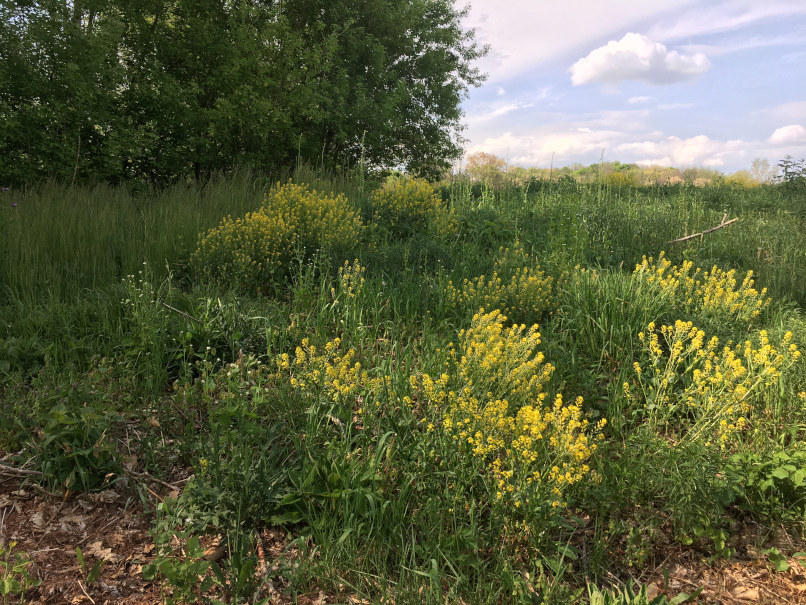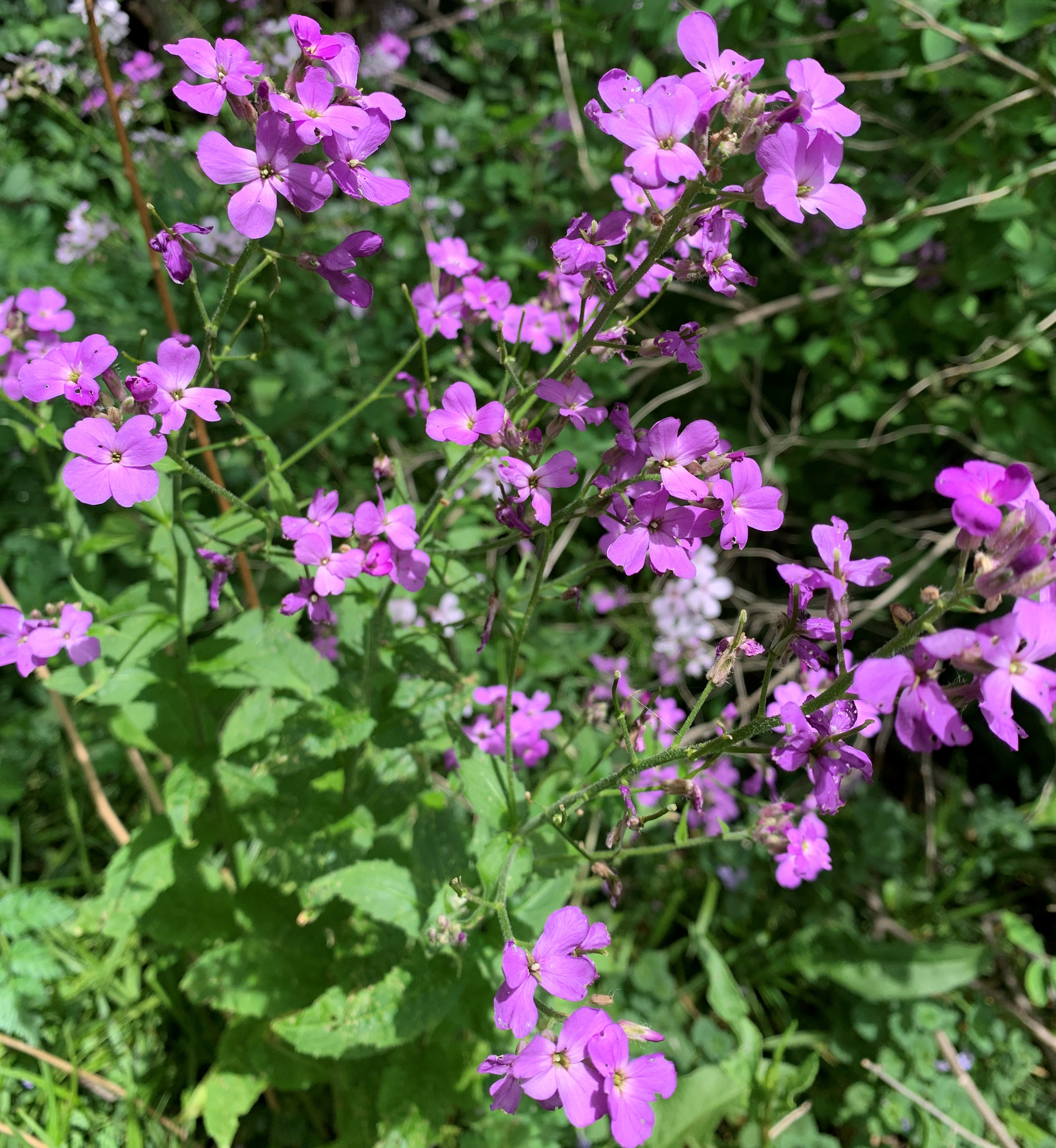Drive-by botany: Yellow rocket and Dame’s rocket
Profiles of common roadside flora in Michigan in May 2021.

Has a patch of flowers ever caught your eye as you travelled down the road? It certainly happens to us all the time! As gardeners and naturalists, we're always interested in increasing diversity in our gardens, so we thought it would be fun to consider some of the roadside plants that we see every day and reflect on whether they would be good additions to a home landscape. Each article in this series will feature two plant species that are currently blooming and frequently observed from the road. Our goal is to answer two simple questions:
- What are they?
- Would they make good garden plants?
As part of the process, we'll include some biological tidbits and a few useful characteristics for identification. Please note that some of the plants we feature are exotic invasive species; we'll be sure to include recommendations from land management professionals on how to manage them in your landscape.
May 2021, East Lansing Michigan – week 22, 1,421 growing degree days (GDD) base 32
Yellow rocket (Barbarea vulgaris)
Common names: Wintercress, bittercress, rocketcress
Yellow rocket is part of the mustard family. Many mustard, including yellow rocket, exhibit a biennial life cycle, spending their first year as a small basal rosette and then sending up flowering stems the following year.

Description
Flowers: Mature plants send up multiple stems that form clusters of radiant yellow flowers on the upper ends. Like all mustards, yellow rocket flowers have four petals.
Leaves: Leaves are smooth, glossy, dark green and relatively thick. The foliage at the base of the plant develop well-pronounced lobes and are usually more smooth and glossy than the upper leaves. The upper leaves become progressively smaller with lobes becoming more like indentations, giving them a "toothy" appearance.
Seeds/fruit: The slender linear fruit, also known as seed pod, is called a silique. Once the tissue matures and dries, siliques usually break open and release their little seeds out into the world (a process called dehiscence).

Distribution: Barbarea vulgaris has been documented in all but five counties within the state of Michigan. It thrives in a wide variety of habitats and is often found in areas that experience frequent ecological disturbance (e.g., tilling, road maintenance).
Blooming period: Depending on the location, flowers start to appear in late April and can be seen along the roadside throughout the month of May and into early June. Although there are several mustard species that look similar, yellow rocket blooms earlier than the others.
Native status: Exotic/introduced. This species is not native to the United States.
Garden uses: According to "Edible Wild Plants" by Elias and Dykeman, leaves, flowers and buds are all edible, but may require blanching in late spring to remove the bitter taste. Yellow rocket is a common agricultural weed. Because of its status as a non-native plant and its propensity to spread, we do not recommend propagating or cultivating this species.
Management: Although it is not considered a highly-concerning invasive in natural areas, yellow rocket can be a problem for turf managers, farmers and nursery operators. Regular mowing can prevent it from becoming an issue in home landscapes.
Common look-alikes: Wild mustard (Sinapis arvensis), black mustard (Brassica nigra) and wild radish (Raphanus raphanistrum).
Dame’s rocket (Hesperis matronalis)
Common names: Dame’s violet
Dame’s rocket is part of the mustard family (Brassicaceae). It is a tall, biennial or short-lived perennial (due to aggressive reseeding) that can grow up to 2 or 3 feet tall. The first-year plants overwinter as an evergreen basal rosette.

Description
Flowers: Flowers range in color from white to pink and purple. They are borne in terminal clusters and can be quite fragrant with a clove-like aroma. Dame’s rocket is sometimes mistaken for phlox species, but flowers have four petals while phlox has five petals.
Leaves: Leaves are lanceolate or ovate-lanceolate with dense hairs and finely toothed margins. Leaves usually become progressively smaller as you move up the stem and are alternately arranged along the hairy stem. This is another characteristic that sets it apart from phlox. Phlox leaves are arranged oppositely along the stem (directly across from each other).
Seeds/fruit: Dame’s rocket also produces a silique. The fruit ripens from June to August and dehisces in late summer to release thousands of seeds.

Distribution: This species has been documented in 44 counties within the state of Michigan. It commonly grows along roadsides and other disturbed sites but spreads readily to adjacent woodlands and wetlands where it is ecologically invasive.
Blooming period: Begins flowering in mid-May and lasts through July.
Native status: Exotic/introduced. This species is not native to the United States.
Garden uses: Dame’s rocket is listed as a noxious weed in several states and should not be planted in the garden due to its invasive tendencies.
Management: Dame’s rocket can spread aggressively at sites due to prolific re-seeding. Efforts can be made to hand pull the mature plants before seeding to prevent further spread. Control efforts should be in place for several years until the seed bank has been exhausted.
Common look-alikes: Wild blue phlox (Phlox divaricata), prairie phlox (Phlox pilosa) and perennial phlox (Phlox paniculata)
Questions? Feel free to contact Jeremy Jubenville or Isabel Branstrom with the Michigan State University Extension floriculture team.
Thank you to Tyler Bassett from the Michigan Natural Features Inventory for his review of this article.
Resources
- Michigan Flora (2001) – E. Voss
- Weeds of the Northeast (1997) – Uva, Neal, and DiTomaso
- Edible Wild Plants (2009) – Elias & Dykeman



 Print
Print Email
Email










